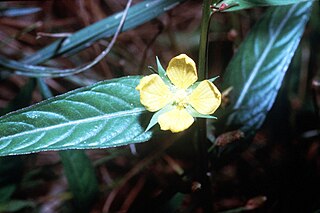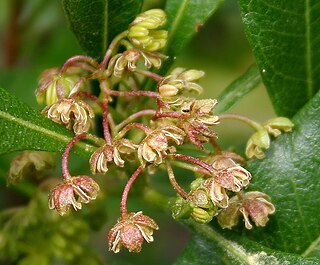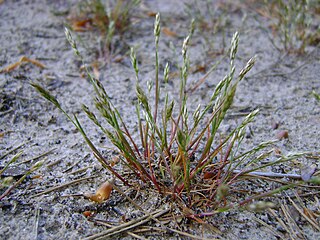
Robinia is a genus of flowering plants in the family Fabaceae, tribe Robinieae, native to North America. Commonly known as locusts, they are deciduous trees and shrubs growing 4–25 metres (13–82 ft) tall. The leaves are pinnate with 7–21 oval leaflets. The flowers are white or pink, in usually pendulous racemes. Many species have thorny shoots, and several have sticky hairs on the shoots.

Physalis angulata is an erect herbaceous annual plant belonging to the nightshade family Solanaceae. Its leaves are dark green and roughly oval, often with tooth shapes around the edge. The flowers are five-sided and pale yellow; the yellow-orange fruits are borne inside a balloon-like calyx. It is native to the Americas, but is now widely distributed and naturalized in tropical and subtropical regions worldwide.

Ludwigia alternifolia, commonly known as seedbox, bushy seedbox, rattlebox, and square-pod water-primrose, is a herbaceous perennial plant of the family Onagraceae. It is native to central and eastern North America, growing in marshes, wet meadows, and swamps. It has yellow, four-petaled flowers and brown seed pods that are shaped like a cube.

Dodonaea viscosa, also known as the broadleaf hopbush, is a species of flowering plant in the Dodonaea (hopbush) genus that has a cosmopolitan distribution in tropical, subtropical and warm temperate regions of Africa, the Americas, southern Asia and Australasia. Dodonaea is part of Sapindaceae, the soapberry family.

The Native Plant Trust, founded in 1900 as the Society for the Protection of Native Plants, and long known as the New England Wild Flower Society, is the nation's first plant conservation organization. The society is dedicated to the preservation of native plants and operates Garden in the Woods at its headquarters in Framingham, Massachusetts. It also offers courses on topics of conservation and horticulture of native plants, manages a "conservation corps" of volunteers throughout New England, operates several native plant sanctuaries, and offers nursery-propagated native plants for sale at its two nurseries.

Cardamine bulbosa, commonly called bulbous bittercress or spring cress, is a perennial plant in the mustard family. It is native to a widespread area of eastern North America, in both Canada and the United States. Its natural habitat is moist soils of bottomland forests and swamps, often in calcareous areas.

Elsholtzia ciliata, commonly known as Vietnamese balm, xiang ru (香薷) or kinh giới in Vietnamese, is a plant native to Asia. In the US, it is commonly known as Crested Late Summer Mint. In US Vietnamese grocery stores, it is called Kinh Gioi, Vietnamese Lemon Balm, or Vietnamese Lemon Mint.
The hybrid elm Ulmus × hollandica 'Viscosa' is probably one of a number of cultivars arising from the crossing of the Wych Elm U. glabra with a variety of Field Elm U. minor. The tree was listed by Loddiges, in his catalogue of 1836 and two years later by Loudon in Arboretum et Fruticetum Britannicum 3: 1378, 1838, as U. viscosa. An early specimen in the Herbarium Dumortier named U. viscosaAudibert was later sunk by Melville as U. × hollandica.

Anthocercis viscosa, also known as sticky tailflower, is a species of shrub in the family Solanaceae, native to the south coast of Western Australia. It grows up to 3 metres in height and produces white or cream flowers between May and February in its native range.

Aira praecox is a species of grass known by several common names, including early hair-grass, yellow hairgrass and spike hairgrass. It is native to Europe, where it is found in dry, sandy places, on rocky outcrops, and in heath grassland. It also grows in North America as an introduced species, where it can be found on the east and west coasts in sandy or rocky areas, such as beaches and roadsides. This is a tuft-forming annual grass growing up to about 10 to 15 centimeters in maximum height. The thin, narrow leaves are located at the base of the stem, and are typically 0.3–2 millimeters wide. It bears small, tightly congested inflorescences of purple-tinted green bisexual spikelets.
Arnica viscosa is an uncommon North American species of flowering plant in the family Asteraceae, known by the common name Mount Shasta arnica.

Smilax glauca, the cat greenbriar or catbriar is a woody vine in the family Smilacaceae. It is native to central and eastern portions of the United States as well as Mexico, where it is a common and conspicuous part of the forest vegetation.

Parentucellia viscosa is a species of flowering plant in the family Orobanchaceae known by the common names yellow bartsia and yellow glandweed. It is native to Europe, but it can be found on other continents, including Australia and North America, as an introduced species.

Suaeda maritima is a species of flowering plant in the family Amaranthaceae known by the common names herbaceous seepweed and annual seablite.

Scutellaria parvula, commonly known as the small skullcap, is a member of the mint family. It is native to eastern and central North America, being most common in the central states and become rare in the east. It is found in areas that provide ample sunlight, such as prairies, glades, and savannas, often in calcareous soil. Flowering time is from late spring to early summer.

Galium asprellum, the rough bedstraw, is a plant species in the family Rubiaceae. It native to eastern Canada and northeastern United States, from North Carolina and Tennessee north to Minnesota, Ontario and Newfoundland. It is considered a noxious weed in New York, Pennsylvania and Vermont, and is abundantly common in the other New England states and in sections of the Great Lakes region. It is a perennial herb. Leaves are simple with three or more leaves per node. Flowers have four petals and are white in color.

Hypericum hypericoides, commonly called St. Andrew's cross, is a species of flowering plant in the St. John's wort family, Hypericaceae. It is native to the Southeastern United States, Mexico, Central America, and the Caribbean. Its preferred habitat is dry woods on acidic soil. It is a small shrub or shrublet that produces yellow flowers with four petals. There are, according to some classifications, 2 subspecies, hypericoides and multicaule. However, the latter of these is usually classified as a separate species, Hypericum stragulum.

Cleome viscosa, the Asian spiderflower or tick weed is an annual herb that grows up to a meter high. It belongs to the family Cleomaceae. It is considered an invasive species and is widely distributed in warm and humid habitats across the Americas, Africa and Asia, and in Australia. It is commonly found during the rainy season.

Salix eriocephala, known as heart-leaved willow or Missouri River willow, is a species of willow native to a large portion of the temperate United States and Canada.

Chrysosplenium americanum, the American golden saxifrage, is a species of golden saxifrage native to eastern North America.

















